Cite this document
(Chinese and Western Music Culture Assignment Example | Topics and Well Written Essays - 2500 words, n.d.)
Chinese and Western Music Culture Assignment Example | Topics and Well Written Essays - 2500 words. https://studentshare.org/music/1836323-mus-327-discussions-questions
Chinese and Western Music Culture Assignment Example | Topics and Well Written Essays - 2500 words. https://studentshare.org/music/1836323-mus-327-discussions-questions
(Chinese and Western Music Culture Assignment Example | Topics and Well Written Essays - 2500 Words)
Chinese and Western Music Culture Assignment Example | Topics and Well Written Essays - 2500 Words. https://studentshare.org/music/1836323-mus-327-discussions-questions.
Chinese and Western Music Culture Assignment Example | Topics and Well Written Essays - 2500 Words. https://studentshare.org/music/1836323-mus-327-discussions-questions.
“Chinese and Western Music Culture Assignment Example | Topics and Well Written Essays - 2500 Words”. https://studentshare.org/music/1836323-mus-327-discussions-questions.


